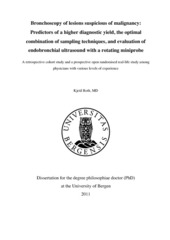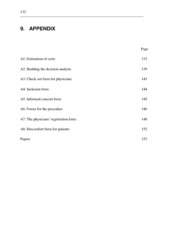| dc.contributor.author | Roth, Kjetil | en_US |
| dc.date.accessioned | 2011-11-28T09:53:49Z | |
| dc.date.available | 2011-11-28T09:53:49Z | |
| dc.date.issued | 2011-11-04 | eng |
| dc.identifier.isbn | 978-82-308-1870-1 (Printed version) | en_US |
| dc.identifier.uri | https://hdl.handle.net/1956/5234 | |
| dc.description.abstract | Aims (1) To evaluate various predictors for a higher diagnostic yield in bronchoscopy (2) To evaluate different combinations of sampling techniques in bronchoscopy of endobronchial visible lesions and peripheral lesions not visible by bronchoscopy (3) To evaluate endobronchial ultrasound (EBUS) with a rotating miniprobe for localisation of peripheral lesions in a real-life situation among pulmonologists at various levels of expertise Methods I: A retrospective cohort study evaluated the results in the study centre before the introduction of EBUS. The study searched for predictors of a higher diagnostic yield and evaluated different combinations of sampling techniques. All 1438 bronchoscopies performed in 2003 and 2004 at Haukeland University Hospital, Bergen, Norway, were retrospectively reviewed and 363 patients with proven malignant lung disease were included in the study. Sex, age, endobronchial visibility, location (lobe), distance from the carina and tumour size were evaluated as possible predictors for a higher detection rate for cancer. Sampling techniques performed were biopsy, transbronchial needle aspiration (TBNA), brushing, small volume lavage (SVL), and aspiration of fluid from the entire procedure. The predictors of a higher detection rate were analysed in bivariate analyses and in multivariate logistic regression. McNemars test compared different combinations of sampling techniques. A cost-minimisation analysis evaluated different combinations of sampling techniques for visible lesions. II: A prospective open randomised trial evaluated EBUS for peripheral lesions and searched for the optimal combination of sampling techniques in peripheral lesions. The study period was from 2005 to 2008 at Haukeland University Hospital and 7 Aalesund Hospital, Norway. The included 264 patients had peripheral lesions on the CT scan and no obvious endobronchial visible tumour on bronchoscopy. A simple randomisation without stratification assigned the patients to either EBUS or conventional bronchoscopy without EBUS. EBUS was performed with a 1.7 mm rotating probe with guide sheath. The study protocol recommended fluoroscopy for both study arms. An intention-to-treat analysis evaluated EBUS and a multivariate analysis was performed to avoid confounding. A cost-effectiveness analysis evaluated different combinations of biopsy, brushing, TBNA and washing. Results The detection rate for cancer in the retrospective study was 17 % in patients with no endobronchial visible lesions, 34 % in patients with endobronchial constriction or compression and 77 % in patients with endobronchial visible lesions. The multivariate logistic regression analysis retained endobronchial visibility and size as significantly predictors of a higher detection rate for cancer. Biopsy and brushing combined with endobronchial needle aspiration (EBNA) was the most economical combination of sampling techniques for endobronchial lesions in a cost-minimisation analysis. The detection rate for cancer in the prospective study was 36 % in the EBUS group and 44 % in the non-EBUS group (ns). The prospective study included only patients without endobronchial visible lesions. There was a significant interaction between size and randomisation to EBUS. Patients with lesions below 3 cm had a significantly higher detection rate in the non-EBUS group. Lesions visualised by EBUS had a higher detection rate for cancer than lesions not visualised by EBUS (62 % vs. 19 %, p<0.01). The cost of one additional positive sample was 1211 euro when brushing was added to biopsy. Based on a willingness to pay of 2800 euro for an additional positive sample, biopsy and brushing was the most cost-effective combination of sampling techniques for lesions not visible by bronchoscopy. The addition of TBNA or washing had cost-effectiveness ratios above 2800 euro. 8 Conclusions 1) Endobronchial visibility and lesion size were significant predictors of a higher detection rate for cancer in bronchoscopy. 2) For visible lesions, biopsy and brushing combined with EBNA was the most economical combination of sampling techniques. For lesions not visible by bronchoscopy, biopsy together with brushing was the most cost-effective combination of sampling techniques. 3) Overall, EBUS did not increase the detection rate for cancer in peripheral lesions when pulmonologists at various levels of expertise performed the bronchoscopies. However, visualisation by EBUS predicted a high detection rate for cancer. | en_US |
| dc.language.iso | eng | eng |
| dc.publisher | The University of Bergen | eng |
| dc.relation.haspart | Paper I: Roth, K., Hardie, J. A., Andreassen, A. H., Leh, F., and Eagan, T. M. L. “Predictors of Diagnostic Yield in Bronchoscopy: a Retrospective Cohort Study Comparing Different Combinations of Sampling Techniques”, BMC Pulmonary medicine 8(2), January 2008. The article is available at: <a href="http://hdl.handle.net/1956/5232" target="blank"> http://hdl.handle.net/1956/5232</a> | en_US |
| dc.relation.haspart | Paper II: Roth, K., Hardie, J. A., Andreassen, A. H., Leh, F., and Eagan, T. M. L. “Cost Minimization Analysis for Combinations of Sampling Techniques in Bronchoscopy of Endobronchial Lesions”, Respiratory Medicine 103(6): 888-94, January 2009. Full text not available in BORA due to publisher restrictions. The article is available at: <a href="http://dx.doi.org/10.1016/j.rmed.2008.12.012 " target="blank"> http://dx.doi.org/10.1016/j.rmed.2008.12.012</a> | en_US |
| dc.relation.haspart | Paper III: Roth, K., Eagan, T. M. L., Andreassen, A. H., Leh, F., and. Hardie, J. A. “A Randomised trial of Endobronchial Ultrasound guided sampling in Peripheral Lung Lesions”. Lung Cancer 74(2): 219-25, November 2011. Full text not available in BORA due to publisher restrictions. The article is available at: <a href="http://dx.doi.org/10.1016/j.lungcan.2011.02.013 " target="blank"> http://dx.doi.org/10.1016/j.lungcan.2011.02.013</a> | en_US |
| dc.title | Bronchoscopy of lesions suspicious of malignancy: Predictors of a higher diagnostic yield, the optimal combination of sampling techniques, and evaluation of endobronchial ultrasound with a rotating miniprobe. A retrospective cohort study and a prospective open randomised real-life study among physicians with various levels of experience | en_US |
| dc.type | Doctoral thesis | |
| dc.rights.holder | Copyright the author. All rights reserved | |
| dc.subject.nsi | VDP::Medical disciplines: 700::Clinical medical disciplines: 750::Oncology: 762 | eng |
| dc.subject.nsi | VDP::Medical disciplines: 700::Clinical medical disciplines: 750::Lung diseases: 777 | eng |

